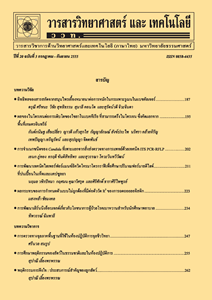ผลของเนื้อเยื่อเริ่มต้นและสารควบคุมการเจริญเติบโตต่อการเพาะเลี้ยงแคลลัสของเจตมูลเพลิงแดงเพื่อผลิตสารพลัมบาจิน
Main Article Content
Abstract
The cultivation of cells and callus is an alternative method for production of pharmaceutically important compounds. Plumbago indica L. is a medicinal plant of Thailand, which its roots are the main source of plumbagin, a naphthoquinone derivative with various pharmacological properties. The induction of callus from leaf and internode explants on solid MS-B5 medium supplemented with 0.2 mg/L NAA, 0.2 or 0.4 mg/L 2,4-D, and 0.1-0.3 mg/L kinetin or BA showed that leaf explant yielded higher callus formation than internode explant. The BA contained media induced better callus formation than using kinetin. Most of them were friable callus, except that observed from leaf explant on 0.2-0.3 mg/L BA was compact callus. For plumbagin analysis, leaf-derived callus accumulated higher plumbagin than internode-derived callus. The results demonstrated that callus from using BA resulted in higher plumbagin content compared with that from kinetin. However, high concentration of 2,4-D may limit the plumbagin production. In this research, the MS-B5 medium containing 0.2 mg/L NAA, 0.2 mg/L 2,4-D and 0.1 mg/L BA was the most suitable medium for producing high fresh and dry weight of callus with the best yield of plumbagin.
Article Details
References
[2] Komaraiah, P., Kavi Kishor, P.B. and Ramakrishna, S.V., 2001, Production of plumbagin from cell suspension cultures of Plumbago rosea L., Biotechnol. Lett. 23: 1269-1272.
[3] Ramachandra Rao, S. and Ravishankar, G.A., 2002, Plant cell cultures: Chemical factories of secondary metabolites, Biotechnol. Adv. 20: 101-153.
[4] Murthy, H.N., Lee, E.J. and Paek, K.Y., 2014, Production of secondary metabolites from cell and organ cultures: Strategies and approaches for biomass improvement and metabolite accumulation, Plant Cell Tiss. Organ. Cult. 118: 1-16.
[5] Murashige, T. and Skoog, F., 1962, A revised medium for rapid growth and bioassays with tobacco tissue culture, Physiol. Plant. 15: 473-479.
[6] Gamborg, O.L., Miller, R.A. and Ojimar, K., 1968. Nutrient requirements of suspension cultures of soybean root cell, Exp. Cell Res. 50: 151-158.
[7] Tsay, H.S. and Agrawal, D.C., 2005, Tissue culture technology of Chinese medicinal plant resources in Taiwan and their sustainable utilization, Int. J. Appl. Sci. Eng. 3: 215-223.
[8] Jamwal, K., Bhattacharya, S. and Puri, S., 2018, Plant growth regulator mediated consequences of secondary metabolites in medicinal plants, J. Appl. Res. Med. Aromat. Plants 9: 26-38.
[9] Rajendran, L., Ravishankar, G.A., Venkataraman, L.V. and Prathiba, K.R., 1992, Anthocyanin production in callus cultures of Daucus carota L. as influenced by nutrient stress and osmoticum, Biotechnol. Lett. 14: 707-714.
[10] Lubaina, A.S. and Murugan, K., 2012, Effect of growth regulators in callus induction, plumbagin content and indirect organogenesis of Plumbago zeylanica, Int. J. Pharm. Sci. 4: 334-336.

